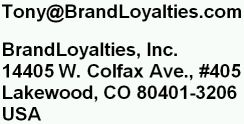
 |
| Home | Basic Concepts White Paper | 3 Minute Overview Video | BrandLoyalties Full Presentation | "Big Data Meets Deep Learning" Video | BrandLoyalties FAQs |

| Home | Basic Concepts White Paper | 3 Minute Overview Video | BrandLoyalties Full Presentation | "Big Data Meets Deep Learning" Video | BrandLoyalties FAQs |